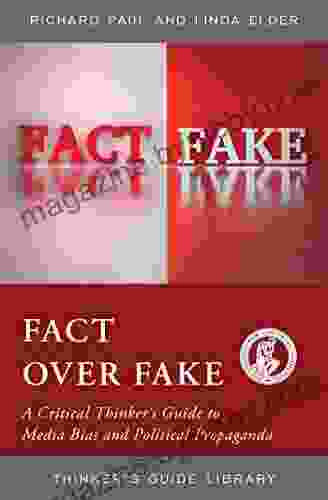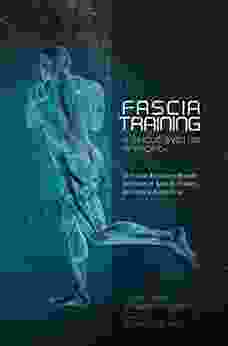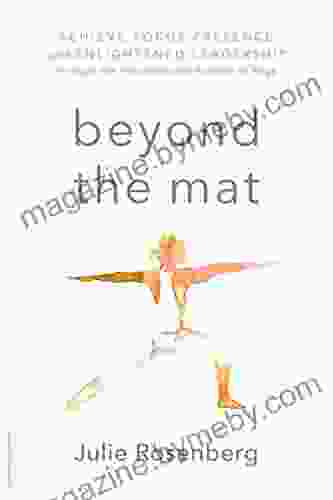Fascia Training: A Whole System Approach

Fascia is a type of connective tissue that surrounds and supports every muscle, bone, organ, and system in the body. It's like the body's internal scaffolding, providing stability, flexibility, and protection.
Fascia is made up of collagen and elastin fibers. Collagen fibers are strong and inflexible, while elastin fibers are stretchy and elastic. This combination of fibers gives fascia its unique properties.
Fascia is found throughout the body, but there are three main types:
4.2 out of 5
| Language | : | English |
| File size | : | 65314 KB |
| Text-to-Speech | : | Enabled |
| Screen Reader | : | Supported |
| Enhanced typesetting | : | Enabled |
| Word Wise | : | Enabled |
| Print length | : | 205 pages |
| Lending | : | Enabled |
- Superficial fascia is located just beneath the skin. It's thin and flexible, and it helps to hold the skin in place.
- Deep fascia is located deeper in the body, surrounding muscles and organs. It's thicker and less flexible than superficial fascia, and it helps to protect and support the structures it surrounds.
- Visceral fascia is located around the organs and blood vessels. It's very thin and delicate, and it helps to keep the organs in place.
Fascia plays a vital role in many bodily functions, including:
- Movement. Fascia helps to transmit force from muscles to bones, allowing us to move. When fascia is healthy, it's flexible and elastic, which allows us to move freely and pain-free.
- Support. Fascia helps to support the body's weight and protect the organs from injury. When fascia is healthy, it's strong and resilient, which helps to prevent pain and discomfort.
- Sensation. Fascia contains nerve endings that transmit sensory information to the brain. This information helps us to feel our bodies and to interact with our environment.
- Metabolism. Fascia helps to regulate blood flow and nutrient delivery to the body's cells. When fascia is healthy, it's able to deliver oxygen and nutrients to the cells, which helps to keep the body functioning properly.
When fascia is healthy, it's pliable and elastic. However, fascia can become tight or restricted due to a variety of factors, including:
- Trauma. Injuries, such as sprains, strains, and fractures, can damage fascia.
- Surgery. Surgery can also damage fascia.
- Lack of movement. When we don't move enough, fascia can become tight and stiff.
- Poor posture. Poor posture can put stress on fascia, causing it to become tight and painful.
- Aging. As we age, fascia naturally becomes less flexible.
When fascia is tight or restricted, it can cause a variety of problems, including:
- Pain. Tight fascia can compress nerves and blood vessels, causing pain.
- Stiffness. Tight fascia can restrict movement, causing stiffness and discomfort.
- Reduced range of motion. Tight fascia can limit the range of motion in joints.
- Muscle weakness. Tight fascia can weaken muscles by reducing their ability to contract.
- Posture problems. Tight fascia can pull the body out of alignment, causing posture problems.
Fascia training is a type of exercise that is designed to improve the health of fascia. Fascia training involves a variety of techniques, such as:
- Stretching. Stretching helps to lengthen fascia and improve flexibility.
- Foam rolling. Foam rolling helps to break up tight fascia and improve circulation.
- Massage. Massage helps to relax fascia and relieve pain.
- Yoga. Yoga is a mind-body practice that combines stretching, strengthening, and breathing exercises. Yoga can help to improve fascial health by increasing flexibility, strength, and circulation.
- Pilates. Pilates is a low-impact exercise that focuses on core strength and flexibility. Pilates can help to improve fascial health by strengthening the muscles that support the fascia.
Fascia training is a safe and effective way to improve the health of fascia. Regular fascia training can help to reduce pain, increase flexibility, and improve range of motion.
Fascia training is especially beneficial for athletes. Athletes put a lot of stress on their bodies, which can lead to fascia becoming tight and restricted. Fascia training can help athletes to improve their performance and reduce their risk of injury.
Fascia training can help athletes to:
- Improve flexibility. Flexible fascia allows athletes to move more freely and with less pain.
- Increase strength. Strong fascia supports the muscles and helps to prevent injuries.
- Reduce pain. Healthy fascia is less likely to compress nerves and blood vessels, which can reduce pain.
- Improve range of motion. Healthy fascia allows athletes to move through a greater range of motion.
- Reduce risk of injury. Flexible, strong fascia is less likely to be injured.
Fascia training is not just for athletes. Anyone can benefit from fascia training. Fascia training can help to reduce pain, increase flexibility, and improve range of motion. It can also help to improve posture, reduce stress, and improve sleep.
If you're new to fascia training, start slowly and gradually increase the intensity and duration of your workouts. Listen to your body and stop if you experience any pain.
Here are some simple fascia training exercises that you can try:
- Cat-cow pose. Start on your hands and knees with your hands shoulder-width apart and your knees hip-width apart. Inhale, arching your back and lifting your head and tailbone. Exhale, rounding your back and tucking your chin to your chest. Repeat 10-15 times.
- Downward-facing dog. Start on your hands and knees with your hands shoulder-width apart and your knees hip-width apart. Inhale, lifting your hips up and back, forming an inverted V-shape with your body. Hold for 5-10 breaths.
- Cobra pose. Lie on your belly with your legs together and your arms at your sides. Inhale, lifting your upper body off the ground, keeping your hips and legs on the ground. Hold for 5-10 breaths.
- Foam rolling. Use a foam roller to massage your muscles and fascia. Roll slowly and gently, applying pressure to the areas that are tight or sore. Hold each position for 30-60 seconds.
Fascia training is a safe and effective way to improve your overall health and well-being. Regular fascia training can help to reduce pain, increase flexibility, improve range of motion, and reduce your risk of injury.
4.2 out of 5
| Language | : | English |
| File size | : | 65314 KB |
| Text-to-Speech | : | Enabled |
| Screen Reader | : | Supported |
| Enhanced typesetting | : | Enabled |
| Word Wise | : | Enabled |
| Print length | : | 205 pages |
| Lending | : | Enabled |
Do you want to contribute by writing guest posts on this blog?
Please contact us and send us a resume of previous articles that you have written.
 Book
Book Novel
Novel Page
Page Chapter
Chapter Text
Text Story
Story Genre
Genre Reader
Reader Library
Library Paperback
Paperback E-book
E-book Magazine
Magazine Newspaper
Newspaper Paragraph
Paragraph Sentence
Sentence Bookmark
Bookmark Shelf
Shelf Glossary
Glossary Bibliography
Bibliography Foreword
Foreword Preface
Preface Synopsis
Synopsis Annotation
Annotation Footnote
Footnote Manuscript
Manuscript Scroll
Scroll Codex
Codex Tome
Tome Bestseller
Bestseller Classics
Classics Library card
Library card Narrative
Narrative Biography
Biography Autobiography
Autobiography Memoir
Memoir Reference
Reference Encyclopedia
Encyclopedia Nick Webb
Nick Webb Juan Carosso
Juan Carosso Uwe G Seebacher
Uwe G Seebacher Johnette Van Eeden
Johnette Van Eeden Roland L Mcintosh
Roland L Mcintosh John Stewart
John Stewart Jasmin Harsono
Jasmin Harsono Judy Dunn
Judy Dunn Julian Block
Julian Block Koichi Hagawa
Koichi Hagawa R B Herkes
R B Herkes Josh Mckenzie
Josh Mckenzie Jonathan W Jordan
Jonathan W Jordan Maggie Glisson
Maggie Glisson John Sedgwick
John Sedgwick Nikesh Shukla
Nikesh Shukla Julie A Ross
Julie A Ross Julia L Kay
Julia L Kay Stuart Brioza
Stuart Brioza Paul Clayton
Paul Clayton
Light bulbAdvertise smarter! Our strategic ad space ensures maximum exposure. Reserve your spot today!

 Aleksandr PushkinRegain Control Of Your Fertility Journey: A Comprehensive Guide for the...
Aleksandr PushkinRegain Control Of Your Fertility Journey: A Comprehensive Guide for the... Bob CooperFollow ·2.2k
Bob CooperFollow ·2.2k Gus HayesFollow ·6k
Gus HayesFollow ·6k Cooper BellFollow ·9.8k
Cooper BellFollow ·9.8k Vincent MitchellFollow ·5.4k
Vincent MitchellFollow ·5.4k Mark TwainFollow ·7.7k
Mark TwainFollow ·7.7k Neil ParkerFollow ·8.1k
Neil ParkerFollow ·8.1k Ira CoxFollow ·19k
Ira CoxFollow ·19k Colin RichardsonFollow ·10.6k
Colin RichardsonFollow ·10.6k

 Efrain Powell
Efrain PowellCritical Thinker's Guide to Media Bias and Political...
In a world awash with information, it has...

 Aubrey Blair
Aubrey BlairMurder Is Bad Manners: An Unforgettable English Mystery
Prepare yourself for a captivating literary...

 Luke Blair
Luke BlairDon't Settle For Safe: Embrace Adventure and Live a Life...
<p>In this inspiring and...

 W.H. Auden
W.H. AudenRoblox Codes Dragon Adventures King Legacy All Combat...
Roblox is a massively popular online game...
4.2 out of 5
| Language | : | English |
| File size | : | 65314 KB |
| Text-to-Speech | : | Enabled |
| Screen Reader | : | Supported |
| Enhanced typesetting | : | Enabled |
| Word Wise | : | Enabled |
| Print length | : | 205 pages |
| Lending | : | Enabled |













